I have been, or can be if you click on a link and make a purchase, compensated via a cash payment, gift, or something else of value for writing this post. As an Amazon Associate, I earn from qualifying purchases. Please read my full Affiliate Disclosure for more information.
Retirement is the perfect time to reimagine your living space into a sanctuary of comfort and relaxation. Retirement house plans are increasingly popular because they focus on creating accessible, cozy, and stylish environments that cater to a laid-back lifestyle.
In this article, you’ll discover a variety of creative and practical ideas to transform your home into a haven of peace and leisure. From open floor layouts to outdoor retreats, these ideas are designed to inspire you to craft the perfect space for your golden years and enjoy every moment of relaxed living.
1. Open-Concept Living Spaces with Cozy Nooks

Many retirees crave a home that feels spacious yet inviting, where they can relax without feeling overwhelmed by clutter or cramped spaces. The idea of open-concept living offers the perfect balance, blending large, flowing areas that foster a sense of freedom with cozy corners that provide comfort. It’s all about creating a home environment that promotes both socializing and solitude. Who wouldn’t want a space that adapts to every mood and activity?
Imagine walking into a bright, airy living room with tall ceilings and wide-open spaces. A plush sectional sofa with soft, textured throws faces a corner nook with a comfy armchair and a small side table for books or tea. Warm ambient lighting from hidden fixtures highlights the gentle hues of the walls and the natural wood accents. The space feels seamless, with subtle transitions between areas, encouraging easy movement and a relaxed vibe. It’s a sanctuary where every detail invites you in.
You can tailor open plans to match your style—whether sleek and modern with minimal furniture or cozy with layered textiles and vintage touches. For seasonal changes, swap out cushions and throws to reflect the time of year. Small spaces can benefit from dividing screens or partial walls to create distinct zones without losing the airy feel. For a more rustic charm, incorporate reclaimed wood accents and warm earthy tones. The key is flexibility to suit your evolving needs.
Start by choosing a layout that maximizes natural light and minimizes obstacles. Use large area rugs to define zones without walls, and invest in multi-purpose furniture like storage ottomans or fold-out tables. Focus on soft, neutral paint colors for walls to enhance the sense of space. Incorporate lighting layers—overhead, task, and accent—to create ambiance at different times. Keep pathways clear for easy navigation, especially if accessibility is a concern. Minimal clutter and thoughtful furniture placement make the space both functional and inviting.
Personalize your open-concept by adding textured textiles such as chunky knit blankets or woven rugs. Incorporate personal photographs in sleek frames or decorative shelves that don’t clutter the space. Use color accents like throw pillows or curtains to add personality. Consider incorporating a statement piece like a sculptural side table or a unique light fixture to serve as a focal point. These touches make the space uniquely yours while maintaining its relaxed vibe.
An open-concept layout offers a versatile foundation for a comfortable, stylish retirement home that adapts as your needs change. It encourages a lifestyle of ease, whether hosting friends or enjoying quiet evenings. With a little planning, you can create a space that feels expansive yet intimate, inspiring confidence in your living environment. Embrace the freedom of flowing spaces designed for relaxed living and personal growth.
2. Low-Maintenance Curb Appeal with Easy-Care Landscaping
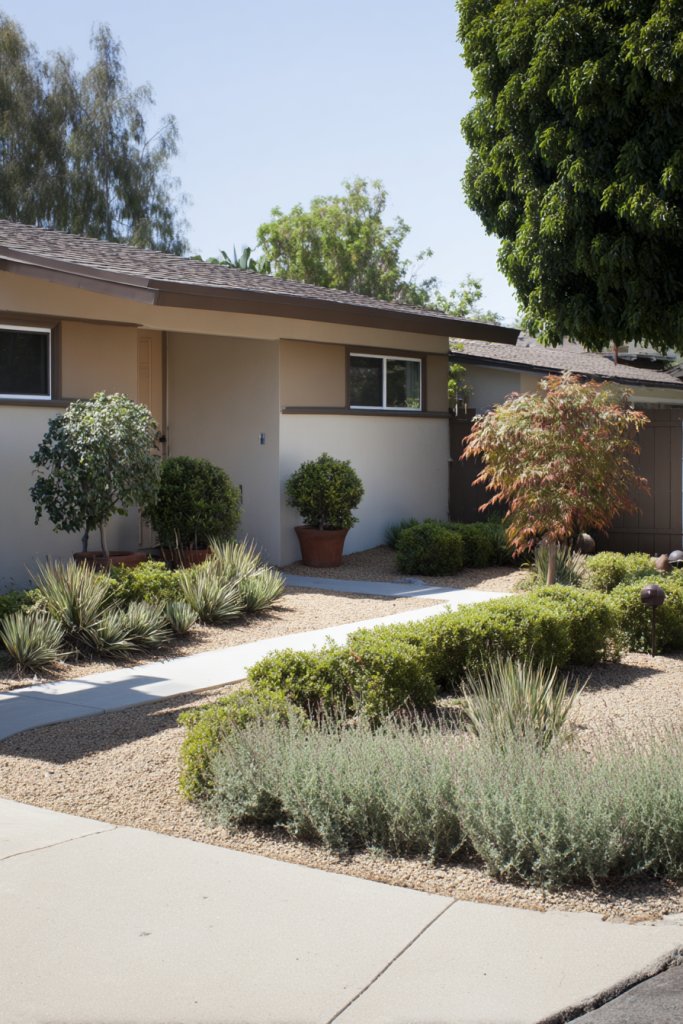
Let’s face it, maintaining a yard can become a chore, especially when you’re looking forward to relaxing rather than constant upkeep. The idea of low-maintenance landscaping appeals to retirees wanting to enjoy their outdoor space without spending hours gardening. It’s about creating a welcoming entrance that remains beautiful with minimal effort. Who doesn’t want a stunning yard that looks effortlessly polished?
Picture a clean, simple front yard with drought-resistant plants clustered in textured beds. Gravel pathways wind through the space, bordered by sleek, low-profile edging that’s easy to maintain. A neat lawn area, complemented by decorative stones and native grasses, adds visual interest without needing frequent watering or trimming. The overall look is neat, modern, and inviting, with a natural harmony that blends with the environment. It’s a yard that greets visitors and relaxes the homeowner alike.
Choose plants suited to your climate—succulents for dry areas, native bushes for more temperate zones. For a splash of color, incorporate hardy perennials that bloom seasonally without requiring lots of attention. For colder climates, opt for evergreens and stone features that won’t need annual replacements. Use mulching and ground covers to suppress weeds and retain moisture, reducing your work. You can also add decorative elements like sculptural rocks or minimalist garden art for a personal touch.
Begin by assessing your yard’s sunlight, soil, and climate to select the right plants. Prepare beds with quality soil and mulch to promote healthy growth. Use drought-tolerant plants that thrive on minimal watering, and install drip irrigation systems for efficient watering. Opt for gravel or decomposed granite pathways to avoid lawn mowing. Regularly prune only when necessary, and avoid overplanting to keep maintenance low. Periodic weeding and mulching are your main ongoing chores.
Add personal flair with decorative stones, textured borders, or small sculptures that complement your style. Incorporate seating areas with weatherproof furniture to enjoy your outdoor space in comfort. Use colorful pots or planters for seasonal flowers, but keep them simple and low-maintenance. Incorporate lighting options like solar path lights to make the yard usable and charming at night. Keep the overall design clean and uncluttered for easy upkeep.
A well-designed low-maintenance yard means more time relaxing and less time fighting weeds or watering. It’s a smart investment that boosts curb appeal while reducing effort. You’ll enjoy a beautiful space that welcomes guests and offers a peaceful retreat. With the right plan, your outdoor area can be both stunning and effortless to care for, giving you more time to enjoy what truly matters.
3. Sunlit Sunrooms for Morning Coffee and Reading
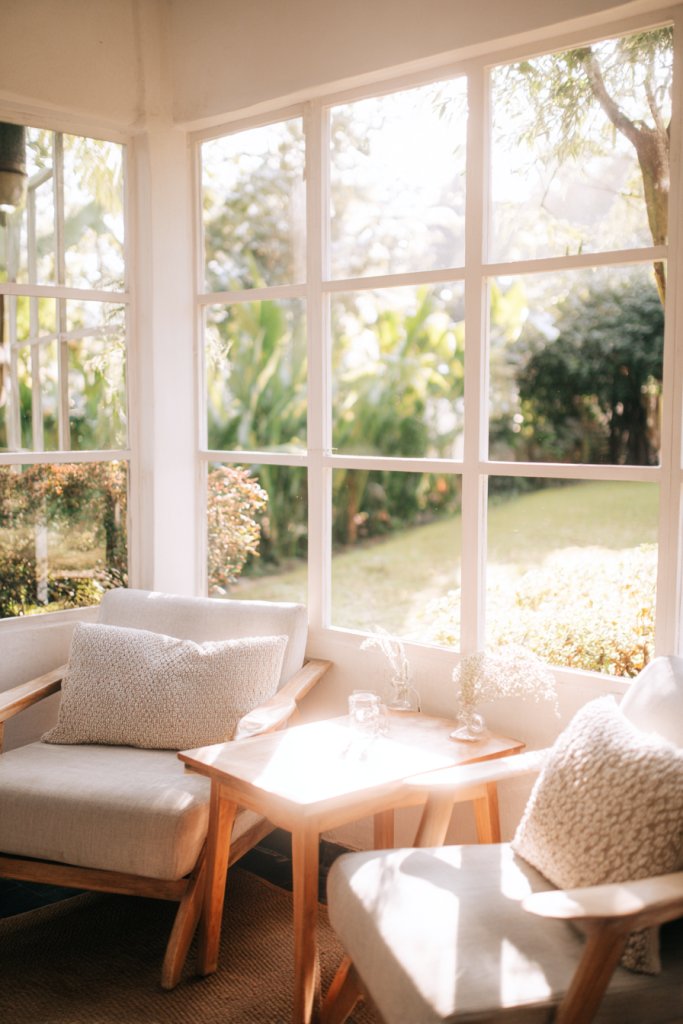
Many retirees dream of a cozy corner where they can start their day with a cup of coffee or lose themselves in a good book. Sunrooms offer a perfect escape—filled with natural light and fresh air—making every morning feel special. It’s about creating a space that enhances relaxation and encourages slow mornings. Who wouldn’t want a personal retreat that feels like a vacation?
Envision a bright sunroom with floor-to-ceiling windows that bathe the space in sunlight. A comfortable armchair with a soft throw blanket and a small side table sit beside a lush potted plant (preferably a faux or decorative alternative). The room features light-colored walls, textured curtains that diffuse the sunlight, and a cozy rug underfoot. The scent of fresh coffee fills the air as gentle sunlight dances across the space, inviting you to unwind.
You can style your sunroom with different themes—rustic, modern, or coastal—by choosing appropriate furniture and textiles. For example, wicker furniture suits beachy decor, while minimalist metal frames work with contemporary aesthetics. Seasonal updates like heavier drapes or decorative textiles can help transition the space from summer to winter. Incorporate adjustable blinds or shades to control sunlight and temperature easily. The key is creating a versatile space that feels inviting year-round.
Start by selecting a room with ample natural light and good ventilation. Use UV-resistant glass or acrylic for windows to reduce glare and heat. Furnish your sunroom with comfortable, easy-care furniture—think weatherproof cushions and wipeable surfaces. Add layered lighting options—such as sconces or indirect lighting—for cozy evenings. Use rugs, curtains, and decorative accents to soften the space and add personality. Regular cleaning of glass and furniture keeps the space bright and welcoming.
Customize your sunroom with seasonal textiles, decorative pillows, or a small bookshelf filled with your favorite reads. Incorporate personal touches like artwork or framed photos on shelves (avoiding wall art restrictions). Use scented candles or diffusers to add calming aromas, enhancing the relaxing atmosphere. Incorporate a small water feature or ambient sound system for extra tranquility. Keep the decor simple but meaningful, making it a true personal sanctuary.
A sunlit retreat can become your go-to spot for starting the day peacefully or winding down in the evening. It adds a touch of luxury to everyday routines while boosting your home’s charm. With minimal effort, you create a space that feels like a daily vacation. Embrace this light-filled haven and enjoy the serenity it brings to your lifestyle.
4. Single-Story Floor Plans for Easy Accessibility
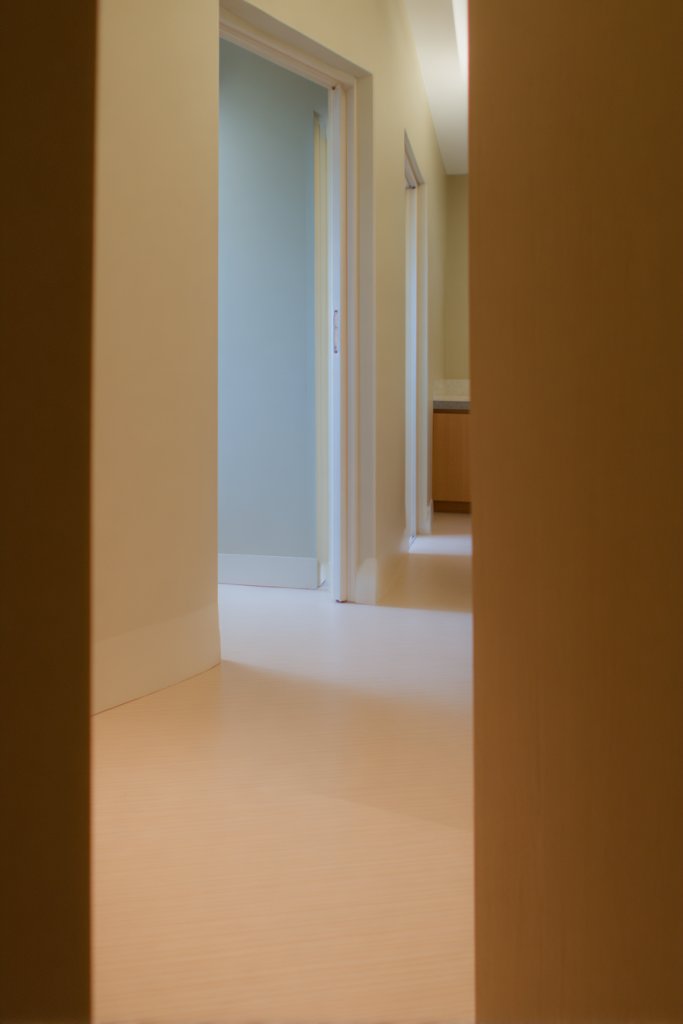
Stairs can be a real barrier as we age, making multi-level homes less practical and more hazardous. A single-story floor plan offers the perfect solution—eliminating steps and creating a home that’s safe and easy to navigate. It’s about comfort, convenience, and peace of mind, especially for those with mobility concerns. Who wouldn’t prefer a home where everything is just a few steps away?
Picture a sprawling ranch-style home with a wide front porch leading into an open, single-level interior. The living room flows seamlessly into a kitchen and dining area, all on the same floor. Wide doorways and hallways accommodate walkers or wheelchairs, with no thresholds to trip over. Large windows bring in natural light, illuminating soft-toned walls and accessible cabinetry. Every detail emphasizes ease of movement and a relaxed lifestyle.
Designs can range from classic ranch styles to modern open layouts—whatever suits your taste. You might incorporate a small mudroom or vestibule at the entrance for added convenience. For seasonal comfort, include energy-efficient windows and insulation. If space allows, add a small outdoor patio accessible directly from the main living area. Personal touches like a cozy reading nook or a craft corner can make the plan uniquely yours.
Begin by choosing a flat plot or one that requires minimal grading. Work with an architect to maximize the open floor concept while maintaining functionality. Focus on wide hallways—at least 36 inches—and lever-style door handles for ease of use. Use durable, low-maintenance flooring like vinyl or laminate throughout. Plan for minimal thresholds or ramps at entry points. Incorporate smart home technology for added safety, such as voice-activated lighting or automated door locks. Focus on natural light to reduce dependence on artificial lighting.
Personalize your space with textured wall finishes or built-in shelving that doesn’t impede movement. Choose furniture with rounded edges and supportive cushions for added comfort. Incorporate accessible storage, such as pull-out cabinets or under-bed compartments. Add decorative accents like colorful textiles or statement lighting fixtures to reflect your style. Keep pathways clear and clutter-free for optimum safety and ease.
A single-story layout isn’t just practical; it’s a lifestyle choice that promotes independence and peace of mind. It simplifies daily routines and reduces potential hazards, making aging in place more achievable. With thoughtful design, you can enjoy all the comforts of home without compromise. This approach empowers you to embrace a relaxed, safe, and stylish living environment.
5. Multi-Functional Guest Suites for Visitors
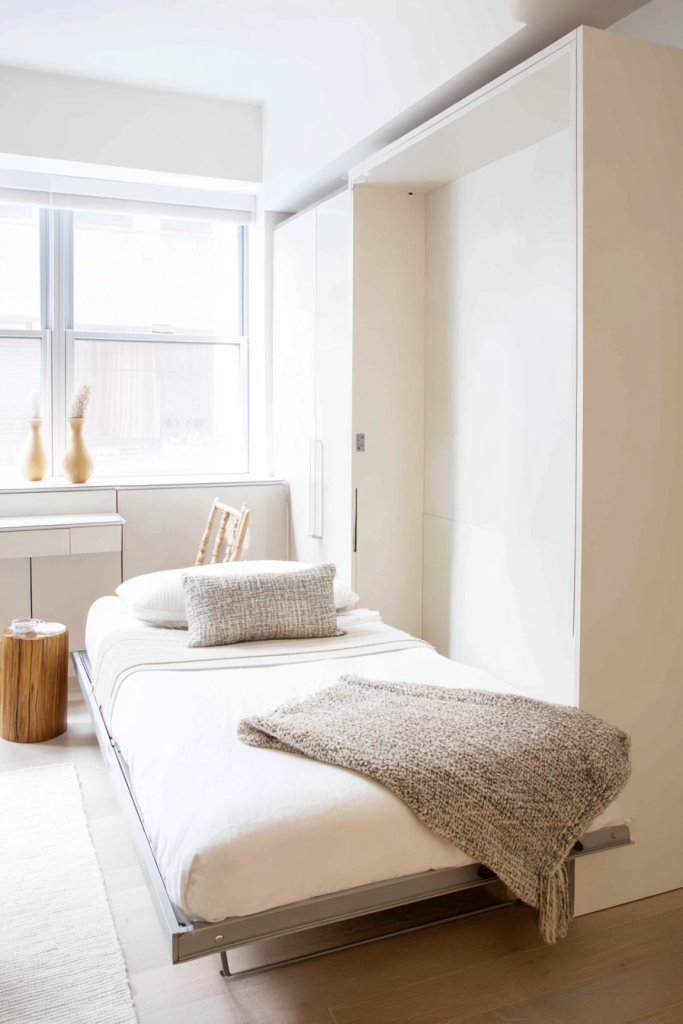
Having visitors stay over is wonderful, but dedicating a large guest room can feel like wasted space—especially if you rarely host. The solution? A versatile guest suite that doubles as something else when not in use. Think of it as a smart investment in your home’s functionality and your lifestyle comfort. Who wouldn’t love a flexible space that adapts to your needs?
Imagine a cozy room with a fold-out sofa bed, a small desk, and built-in shelves. When guests arrive, the room transforms into a welcoming guest suite with fresh linens and a warm throw blanket. When not hosting, the space becomes a hobby or craft room with a fold-away worktable and storage for supplies. Light colors and simple decor keep the room feeling open and adaptable, whether it’s used for sleeping, working, or relaxing.
Choose furniture with hidden storage or multi-purpose features—like a murphy bed or a daybed with drawers. Decorate with neutral tones and minimal accessories so it remains versatile. For seasonal variations, add decorative textiles or wall coverings that can be easily changed. Incorporate a fold-down wall desk for a home office function or a small sewing corner. The goal is maximizing usability without clutter.
Start with a room that has good natural light and is accessible from common areas. Use fold-away or wall-mounted furniture to save space. Install wall-mounted shelving or cabinets to keep supplies organized. Use neutral, durable paints that won’t clash with multiple functions. For comfort, add a supportive mattress or fold-out sofa with quality cushions. When designing, consider electrical outlets and lighting for both daytime and night use. Flexibility is the key.
Personalize the space with decorative textiles that can be swapped seasonally, like cozy throws or vibrant curtains. Add personal touches such as framed photos or decorative cushions that match your style. Use storage bins or baskets to keep supplies tidy when in hobby mode. Consider adding a small, portable speaker system for entertainment. Keep the space simple and functional, with a personal flair.
A multi-functional guest suite offers both practicality and style, making your home more adaptable. It’s a smart way to prepare for visitors without sacrificing space or aesthetics. This flexibility allows your home to evolve with your needs, keeping it fresh and useful. Embrace the potential of every room and enjoy a home that truly works for you.
6. Relaxing Master Suites with Spa-Like Bathrooms
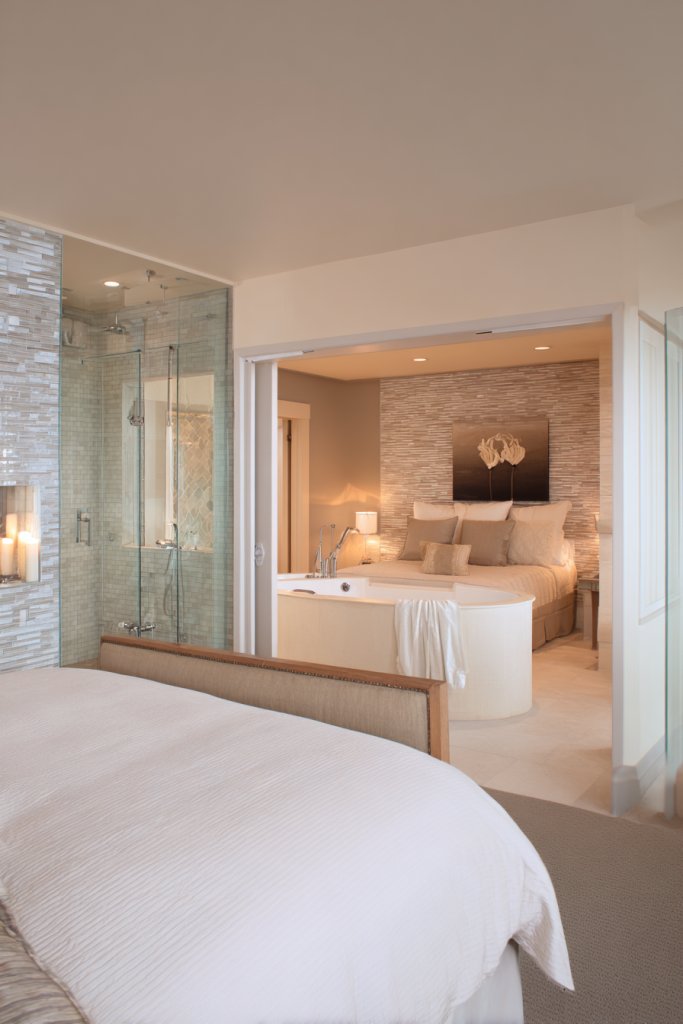
Your bedroom should be a sanctuary—an escape from daily stress where you can unwind and rejuvenate. A master suite that feels like a spa offers the ultimate retreat within your home. It’s about creating a space that combines comfort, luxury, and tranquility. Who wouldn’t want a personal spa at their fingertips?
Picture a spacious bedroom with soft, neutral walls and plush bedding topped with a multitude of textured pillows. Adjacent is a bathroom featuring a deep soaking tub, a walk-in shower with multiple shower heads, and calming color schemes. Large windows with privacy shades let in natural light, while soft lighting fixtures cast a warm glow. Aromatherapy diffusers and subtle scents fill the air, completing the spa-like ambiance.
You can style your suite with various themes—minimalist with sleek lines and monochrome palettes or more ornate with luxurious textiles and decorative accents. For a seasonal touch, incorporate plush rugs, heated flooring, or decorative tiles. Use calming colors like soft blues, greens, or earth tones to promote relaxation. Add built-in storage to keep the space uncluttered and serene, whether in the bedroom or bath.
Start by choosing a quiet, spacious part of your home. Invest in quality, water-resistant flooring and moisture-proof wall finishes. Install a large, comfortable bed with supportive pillows and high-thread-count sheets. In the bathroom, opt for a walk-in shower with multiple jets and a soaking tub with easy access. Use dimmable lighting and install a ventilation system to keep the space fresh. Personalize with towel warmers and a vanity with ample storage.
Add plush towels, decorative baskets, or a set of luxurious robes to elevate the spa experience. Incorporate scented candles or essential oil diffusers—just be sure to avoid any restricted decor. Use textured wall coverings or subtle patterns to add visual interest without clutter. Consider installing a small, private sitting area or a vanity for grooming routines. Keep the design simple but indulgent.
A spa-like master suite transforms your home into a daily retreat, boosting your sense of well-being. It encourages self-care and offers a peaceful sanctuary to relax and recharge. With thoughtful planning, your space can feel both luxurious and functional. Embrace this personal oasis and enjoy a lifestyle focused on comfort and wellness.
7. Bright, Neutral Color Schemes for a Calming Atmosphere
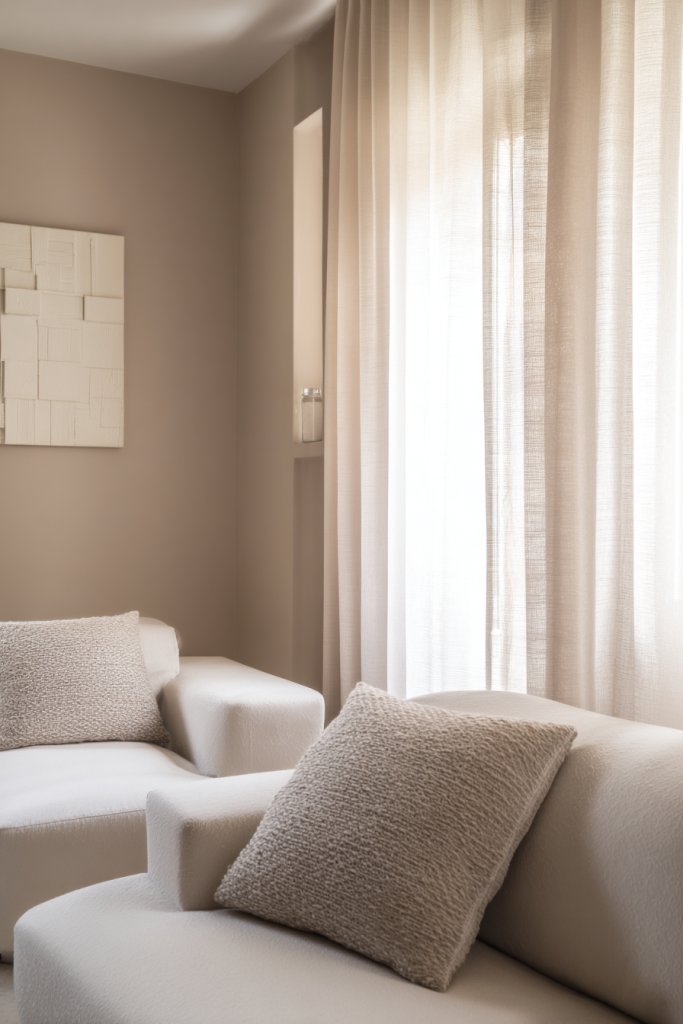
Color plays a huge role in how we feel at home. Bright, neutral palettes are perfect for creating a calming environment, especially for those seeking peace after years of busy schedules. They make spaces feel open, airy, and serene—ideal for unwinding. Who wouldn’t want a home that naturally soothes the soul?
Imagine a living room painted in soft beige with accents of white and gentle pastels. Textured cushions, woven throws, and plush rugs add warmth without overwhelming the senses. Large windows let in sunlight, amplifying the light, neutral tones. The overall aesthetic feels clean, fresh, and uncluttered, inviting you to relax and breathe deeply. Every element contributes to a peaceful, harmonious space.
You can adapt this scheme to any style—modern minimalism with sleek lines and monochrome palettes or cozy farmhouse with layered textiles and vintage-inspired accessories. For seasonal adjustments, swap out textiles or add subtle decorative elements like metallic accents or subtle patterns. Use different shades of the same color family to add depth and interest without disrupting the calm.
Start with a neutral base—white, cream, or taupe walls—and choose furniture in muted tones that complement the palette. Incorporate natural materials such as wood, jute, or linen to enhance the soothing effect. Use layered lighting—warm ambient lights, task lighting, and accent lamps—to create a cozy atmosphere in the evenings. Keep decor minimal, focusing on quality over quantity. Regular cleaning and decluttering maintain the calming vibe.
Add personal touches with textured textiles like cable-knit throws or embroidered cushions. Use decorative baskets or storage trunks to keep clutter out of sight. Incorporate subtle metallic or wood accents for visual interest. Keep window treatments light and breezy—sheer curtains or simple blinds—so natural light remains a feature. The goal is simplicity that feels intentional and peaceful.
A neutral color scheme promotes a relaxing environment that can evolve with your style. It’s easy to refresh with minor updates, making it a smart choice for long-term comfort. This aesthetic fosters peace of mind and mental clarity, transforming your home into a sanctuary. Embrace the simplicity and let your space work for your well-being.
8. Built-In Storage Solutions to Reduce Clutter
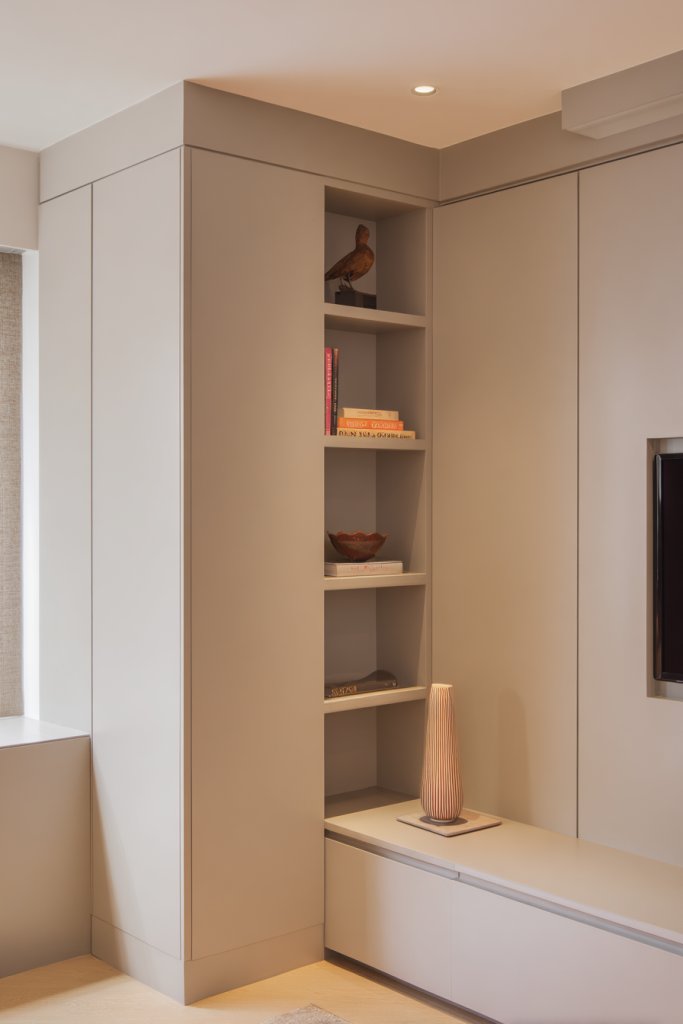
Clutter can turn a cozy home into a chaos zone, especially when space is limited. Built-in storage offers an elegant solution—helping you hide away clutter and keep surfaces clear. It’s about creating a home that feels calm, organized, and welcoming. Who wouldn’t want a space where everything has its place?
Visualize sleek wall niches filled with decorative baskets and neatly folded textiles. A built-in bookshelf stretches from floor to ceiling, holding your favorite books and decorative items without taking up extra space. Under-stair storage compartments hide seasonal décor or seldom-used items, maintaining a clean look. The design seamlessly integrates into the architecture, blending form and function effortlessly.
Customizable options include hidden cabinets, floating shelves, or integrated drawers. Use soft-close mechanisms to prevent noise and enhance durability. For a modern look, choose minimalist finishes like matte white or natural wood tones. In traditional homes, opt for ornate moldings and decorative trims that match existing architecture. Flexibility allows these solutions to fit any style or room size.
Start by identifying clutter hotspots—living rooms, bedrooms, or hallways—and plan storage accordingly. Work with a carpenter or designer to create custom units that optimize your space. Use durable, easy-to-clean materials like laminate or painted MDF. Incorporate adjustable shelves and pull-out drawers for versatility. Install hardware that’s smooth and accessible, especially for those with mobility challenges. Regularly reassess storage needs to avoid overstuffing.
Personalize built-ins with decorative molding or hardware to match your style. Add baskets, bins, or fabric-lined compartments for organization. Use labels or color coding for quick access. Incorporate lighting inside cabinets or shelves for added functionality. Keep the look cohesive by choosing finishes that complement your furniture and decor. The goal is a clutter-free, harmonious environment.
Built-in storage transforms chaotic spaces into calm retreats, boosting your sense of control and peace. It’s a practical investment that pays off by making everyday living smoother. With clever design, your home becomes more spacious and serene. Embrace these solutions and enjoy a clutter-free, stylish sanctuary.
9. Outdoor Living Areas with Comfortable Seating
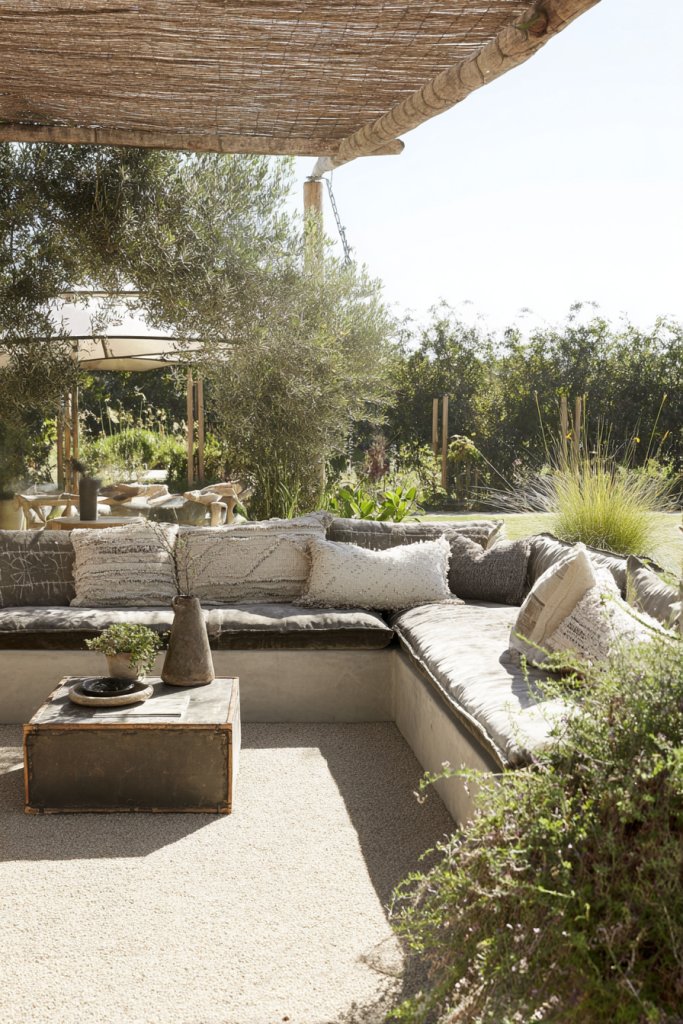
Spending time outdoors is one of life’s simple pleasures, yet many retirees lack a cozy, functional outdoor space for relaxation. Creating an inviting outdoor living area extends your home’s comfort and offers a fresh retreat right outside your door. Imagine relaxing afternoons with a good book or lively evenings with friends—without leaving home. Sounds tempting, right?
Picture a spacious patio with weatherproof sectional seating topped with plush cushions and textured throws. A dining area with a sturdy table and matching chairs invites alfresco meals. String lights or lanterns hang overhead, casting a warm glow as the sun sets. Potted plants and decorative gravel define the space, blending comfort with style. The overall effect is a welcoming oasis designed for leisure and socializing.
Choose furniture in weather-resistant materials—resin wicker, metal, or treated wood—to suit your style. For a relaxed vibe, add large, colorful cushions and casual textiles. Seasonal updates like outdoor rugs or decorative throws can change the mood throughout the year. Incorporate a built-in fire pit or heater for cooler evenings. Personal touches like a small water feature or decorative lighting enhance the ambiance.
Start by assessing your outdoor space and climate conditions. Select durable furniture suited for your weather—UV-resistant, rust-proof, and easy to maintain. Use outdoor-grade fabrics for cushions, and consider adding a shade structure like a pergola or umbrella. Install lighting solutions like solar-powered lanterns or string lights for nighttime use. Incorporate planters with low-maintenance plants for added greenery. Regular cleaning and seasonal care keep the space inviting.
Add personal touches with decorative pillows, outdoor rugs, or custom furniture covers. Incorporate a compact, portable speaker for music or a small table for drinks and snacks. Use decorative lanterns or candles for evening ambiance, ensuring safety. Enhance your space with a variety of seating options—benches, lounge chairs, or even a hammock. Keep everything functional and cozy, making the outdoors an extension of your home.
A well-designed outdoor area invites you to enjoy nature and leisure right at home. It boosts your home’s value and makes every day feel like a vacation. With a little effort, your outdoor space becomes a favorite spot for relaxation and gatherings. Embrace the outdoors and create a personal haven that encourages peace and happiness.
10. Energy-Efficient Windows and Insulation for Comfort
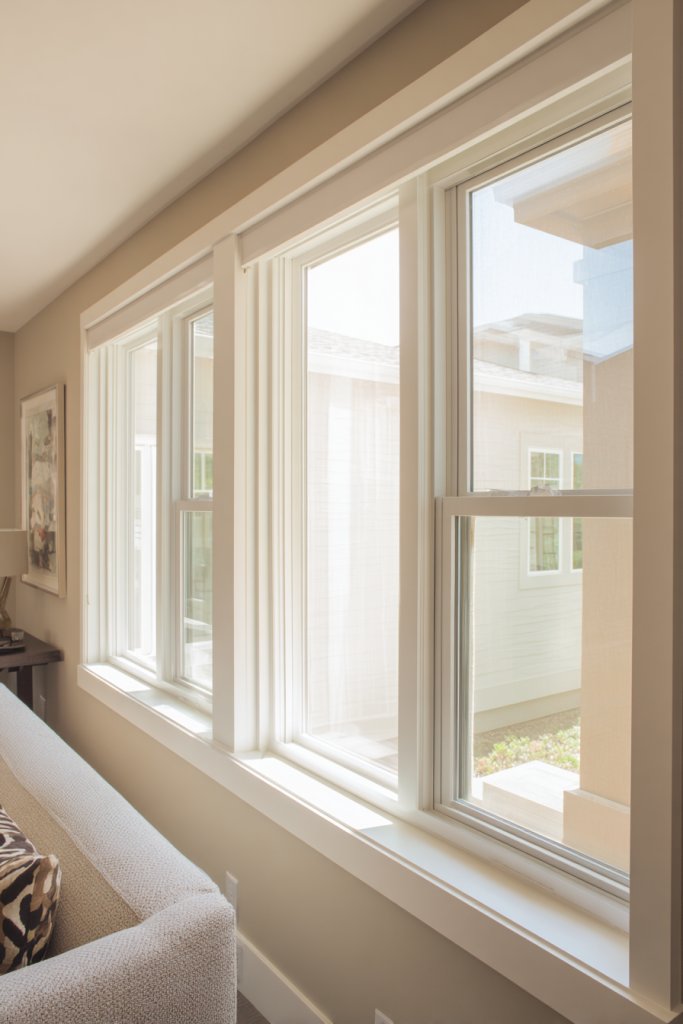
Nothing ruins a relaxing day faster than drafts, cold spots, or overly hot rooms. Energy-efficient windows and insulation are essential for maintaining a comfortable indoor climate all year round. They help you save on energy bills and reduce environmental impact, which is a win-win for responsible living. Who wouldn’t want a home that’s cozy and eco-friendly?
Imagine large, double-glazed windows with sleek frames that let in abundant natural light while keeping noise out. The walls are filled with rigid foam or spray foam insulation hidden behind finished surfaces. During winter, the warmth stays inside, and in summer, the house remains cool without cranking the AC. The overall effect is a home that feels consistently comfortable, quiet, and well-sealed. It’s a subtle upgrade that makes a big difference.
Choose window styles that match your home’s architecture—casement, picture, or tilt-and-turn—while prioritizing energy savings. For insulation, options range from spray foam and blown-in cellulose to insulated window frames and storm windows. For seasonal variations, add thermal curtains or cellular shades for extra insulation. The emphasis should be on high R-value materials that keep your home warm in winter and cool in summer.
Begin by assessing your current windows and wall insulation levels. Work with professionals to upgrade to energy-efficient options, ensuring proper installation to prevent leaks. Use low-emissivity coatings on glass to reflect heat without sacrificing light. Seal all gaps around windows and doors with weatherstripping or caulk. For walls, consider blown-in insulation or foam board inserts during renovations. Regular maintenance and upgrades keep your home efficient over time.
Personalize your energy solutions with decorative window trims or blackout curtains that also improve insulation. Choose window frames in colors that complement your exterior aesthetic. Add reflective films or solar screens for additional heat control. Incorporate smart thermostats that optimize heating and cooling based on occupancy. These upgrades combine style, comfort, and savings seamlessly.
Upgrading to energy-efficient windows and insulation is an investment in your comfort and the environment. It creates a more consistent indoor climate, reducing stress and energy costs. Your home becomes a haven of tranquility, no matter the weather outside. Take pride in your smart, sustainable choices and enjoy the benefits for years to come.
11. Compact, Easy-Care Kitchen Design with Modern Appliances

Kitchen chores can quickly become overwhelming, especially with aging appliances or cluttered layouts. A compact, easy-care kitchen simplifies cooking and cleaning, making mealtime less stressful. It’s about designing a space that encourages healthy eating and effortless maintenance. Who wouldn’t want a kitchen that’s both functional and low-hassle?
Imagine a sleek kitchen with streamlined cabinets, a built-in oven, and a smooth induction cooktop. The countertops are clear, with minimal clutter—just a few essential tools and a cutting board. Hidden storage keeps utensils and ingredients out of sight, while soft-close drawers and cabinets add a touch of luxury. Bright, energy-efficient LED lighting highlights the space, making it feel fresh and inviting. It’s a functional yet stylish hub where cooking becomes a pleasure.
Choose modern appliances with energy-saving features—think convection ovens and smart refrigerators. Use durable, stain-resistant surfaces like quartz or solid surface countertops for easy cleaning. For smaller spaces, incorporate pull-out pantry shelves and compact appliances that maximize every inch. Seasonal touches like colorful dish towels or decorative jars add personality without cluttering. Keep the design simple, clean, and adaptable.
Start by planning an efficient layout—preferably a galley or L-shape—focused on workflow. Select appliances with high energy ratings and features like self-cleaning or touch controls. Use non-porous, easy-to-wipe surfaces for counters and backsplashes. Install under-cabinet lighting for task illumination. Opt for open shelving or minimal upper cabinets to keep the space feeling open. Regular cleaning and maintenance prolong the life of appliances and surfaces.
Add personalized touches with colorful accessories, such as a set of matching utensils or a decorative spice rack. Use slide-out trash and recycling bins to keep waste organized and out of sight. Incorporate a small herb garden on the windowsill or a magnetic knife strip for quick access. Keep everything organized with labeled containers and drawer dividers. Make it your own with functional, stylish details.
A compact, easy-care kitchen empowers you to cook with less fuss and more enjoyment. It simplifies daily routines and keeps your home looking tidy. With thoughtful design, you’ll find meal prep becomes quicker and more pleasant, encouraging healthier habits. Enjoy a kitchen that’s as practical as it is beautiful, making every meal a joy.
12. Peaceful, Walled Gardens for Private Retreats

Everyone needs a peaceful escape, especially when life gets busy or stressful. Walled gardens provide a private sanctuary where you can relax, reflect, or simply enjoy nature without prying eyes. It’s about creating a personal retreat that offers calm and tranquility right in your backyard. Who wouldn’t want their own hidden oasis?
Visualize a small, enclosed garden with tall, natural hedges or stone walls that shield it from the outside world. A winding stone pathway leads to a cozy seating area with a weatherproof bench or swing. Low-maintenance plants, like succulents or native grasses, fill the beds, adding texture and color. Soft lighting or lanterns cast a gentle glow in the evening, transforming the space into a magical retreat. It’s a peaceful haven designed solely for your enjoyment.
You can style your garden with different themes—Japanese Zen, rustic cottage, or modern minimalist—by choosing appropriate materials and plants. For added privacy, incorporate decorative screens or trellises with climbing plants (or decorative alternatives). Seasonal decor like solar-powered fairy lights or wind chimes enhances the atmosphere. Use durable furniture such as metal or treated wood to withstand weather conditions. The key is creating a space that feels like your own personal escape.
Start by selecting a quiet, accessible spot with good sunlight and drainage. Build or install walls using durable materials like stone, brick, or weatherproof fencing. Design beds with low-maintenance plants suited to your climate—think drought-resistant or native varieties. Incorporate a small seating area with weatherproof cushions or a bench. Add lighting options for evening use, such as solar lanterns or string lights. Regular pruning and cleaning keep the space inviting.
Personalize the garden with decorative elements—think textured stones, sculptures, or decorative signs. Use cushions in weatherproof covers to make seating comfortable. Incorporate a small water feature or bird feeder for additional tranquility and wildlife. Use outdoor rugs or mats to define sitting areas. Keep the overall design simple and clutter-free for maximum relaxation.
A walled garden offers a private oasis that nurtures your well-being and provides a daily retreat. It’s a space you control entirely, where stress melts away amid natural beauty. With thoughtful planning, your garden becomes a restorative escape that enhances your home’s value and your lifestyle. Embrace this tranquil space and enjoy the peace it brings.
13. Ambient Lighting with Dimmable Fixtures

Lighting can make or break the mood of a room. Bright, harsh light may be practical, but it doesn’t promote relaxation. Ambient lighting with dimmable fixtures creates a warm, inviting environment perfect for unwinding after a long day. Who wouldn’t want a home that adjusts to every moment with just a flick?
Imagine a living room softly illuminated by recessed ceiling lights, complemented by wall sconces that cast gentle pools of light. A cluster of table lamps with dimmer switches sits on side tables, ready to set a cozy tone. The warm glow highlights plush textiles and textured wall finishes, creating an atmosphere that feels both intimate and elegant. The lighting can be adjusted to suit whether you’re reading, relaxing, or entertaining.
Choose fixtures that match your decor style—sleek LED panels for modern spaces or antique-style sconces for classic interiors. Incorporate smart dimmer switches for effortless control, or opt for remote-controlled fixtures in hard-to-reach areas. Use layered lighting—overhead, task, and accent—to create depth and flexibility. Seasonal adjustments might include warmer bulbs in winter or brighter settings for brighter evenings.
Start by planning your lighting layout, focusing on areas where you spend most of your time. Invest in dimmable LED bulbs and compatible fixtures—think flush mounts, sconces, or hidden LED strips. Install dimmer switches to give you full control over light levels. Use warm white or soft yellow tones to enhance the cozy atmosphere. Regularly clean fixtures and replace bulbs to maintain optimal function.
Add decorative details like textured lamp shades or frosted glass covers to soften the light. Incorporate smart home systems to automate lighting scenes for different moods or times of day. Use candle-like LEDs or flameless candles as accents—no fire hazard, just ambiance. Keep controls simple and accessible, ensuring everyone can adjust the lighting to their preference.
Proper ambient lighting transforms your home into a warm, relaxing haven. It allows you to control mood and atmosphere effortlessly, making every evening special. With the right fixtures and technology, you can enjoy tailored lighting that enhances your lifestyle. Embrace the power of subtle illumination and create the perfect setting for every moment.
14. Multi-Use Hobby Rooms for Creative Pursuits
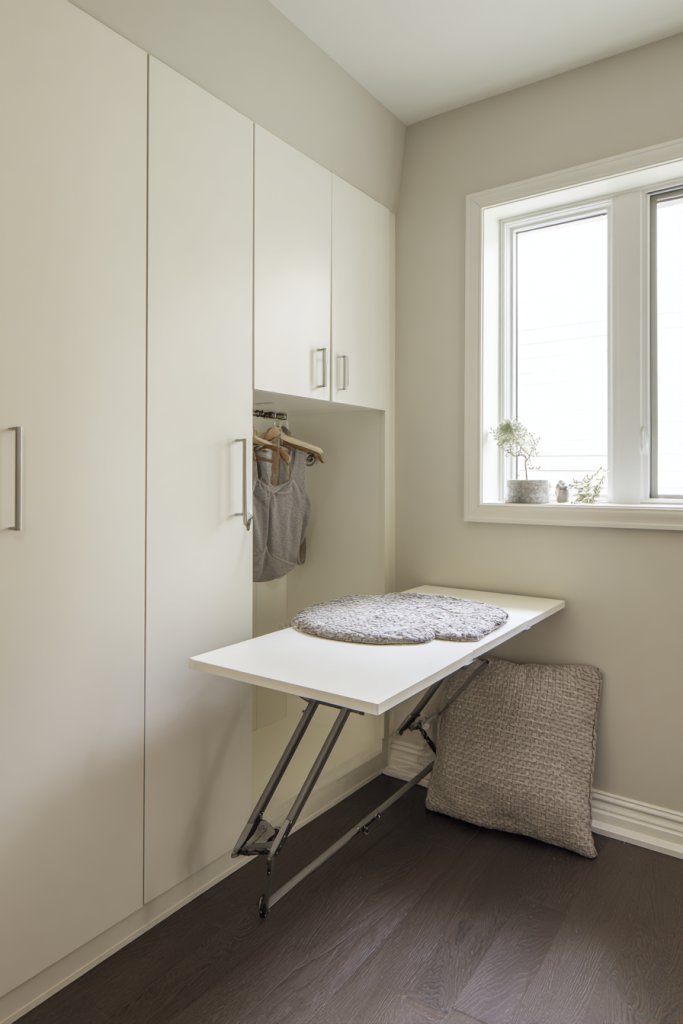
Having a dedicated space for hobbies can dramatically improve your quality of life, helping you stay creative and engaged. Multi-use hobby rooms adapt to your interests, whether it’s painting, gardening planning, or woodworking. It’s about creating a personal sanctuary that fuels your passions without cluttering the rest of your home. Who wouldn’t want a space that sparks joy?
Picture a bright room with large windows, filled with a sturdy worktable, storage cabinets, and adjustable shelving. A corner is set up with art supplies, complete with a comfortable, supportive chair and ample natural light. In another part, a crafting station with organized bins and a pegboard for tools keeps everything accessible. The walls are painted in calming, neutral tones to promote focus and inspiration. It’s a versatile space that encourages hours of productive fun.
Customize the room based on your hobbies—add a large easel and storage for art supplies, or install a sturdy workbench for woodworking. Use adjustable shelving and drawer units to keep supplies organized and accessible. Decorate with inspiring artwork or motivational quotes (avoiding wall decor restrictions). Incorporate a comfy chair or standing desk for long projects. Make it a space that adapts to your evolving interests.
Start with a quiet, well-lit room with durable flooring—like laminate or sealed concrete—that handles messes and spills. Install plenty of storage—cabinets, pegboards, or rolling carts—to keep tools and supplies organized. Use adjustable work surfaces and task lighting to suit different projects. Keep the space clutter-free by regularly sorting and storing supplies. Consider ventilation or extraction fans for projects involving fumes or dust. Personalize with functional decor that enhances your productivity.
Add personal touches like colorful storage bins or motivational posters. Incorporate a small sound system or noise-canceling headphones for focus. Use decorative storage solutions like vintage suitcases or craft baskets to inject personality. Keep tools within easy reach on magnetic strips or pegboards. Regularly update the space with new organizers or decorative accents that reflect your style. Make it your creative haven.
A dedicated hobby room nurtures your creativity and keeps your home organized. It’s a space that encourages exploration, relaxation, and skill-building. With a little effort, your home becomes a hub of inspiration and productivity. Embrace this personal retreat and enjoy the endless possibilities it offers for your passions.
15. Comfortable, Supportive Seating in Living Areas
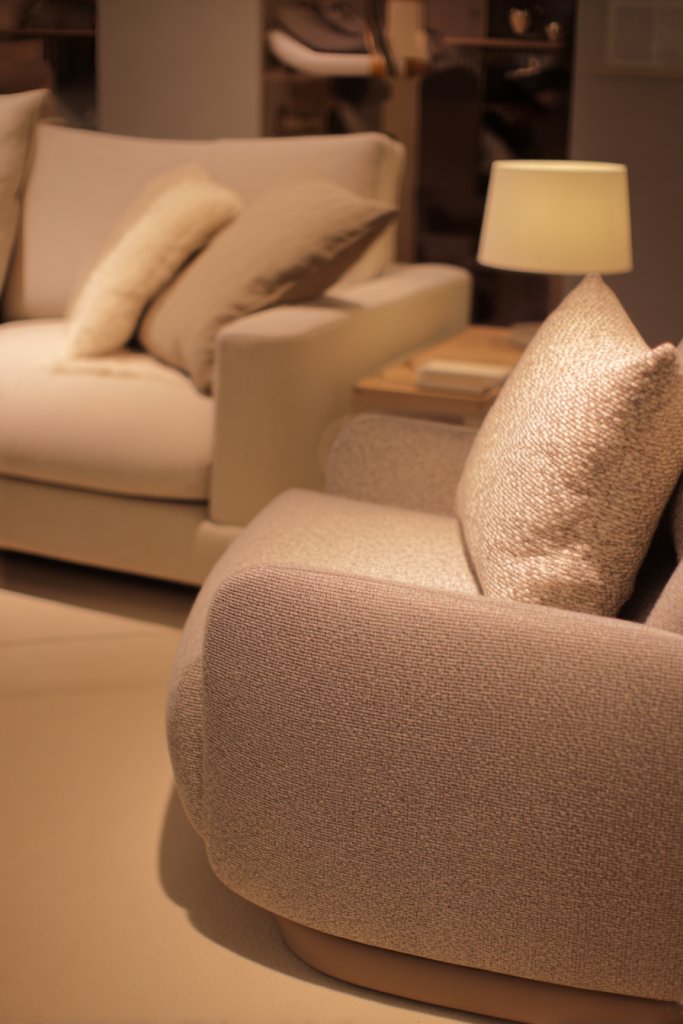
Comfortable seating isn’t just about luxury—it’s essential for relaxing, socializing, and staying supported as we age. Supportive furniture can reduce aches and pains while encouraging longer conversations or leisure hours. It’s about prioritizing health and happiness in your daily environment. Who wouldn’t want furniture that feels like a hug?
Imagine a plush sofa with ergonomic cushions, paired with supportive armchairs that invite you to sit for hours. Rich textures like velvets or soft leathers add tactile comfort, while supportive cushions help maintain good posture. The furniture is arranged to promote conversation, with a central coffee table within easy reach. Warm lighting and textured throws complete the cozy scene, making every seat a throne of relaxation.
Choose furniture with firm, supportive cushions and high backs for lumbar support. Use slipcovers or removable cushions in different textures—wool, chenille, or memory foam—for added comfort. For smaller spaces, opt for multi-functional pieces like loveseats or recliners with adjustable positions. Incorporate furniture with rounded edges and non-slip feet for safety. Style can range from modern minimalism to classic plush, depending on your taste.
Prioritize ergonomic design—look for supportive backrests, cushioned armrests, and firm but comfortable seating surfaces. Test furniture in-store for comfort and support, especially if you have mobility issues. Use high-density foam or memory foam cushions for added support. Arrange furniture to encourage social interaction and ease of movement. Regularly fluff cushions and check support features to maintain comfort and safety. Focus on durability and ease of cleaning.
Add decorative textiles like throws or decorative pillows in textured fabrics. Incorporate a variety of seating options—ottomans, side chairs, or reclining sofas—to suit different needs. Use furniture in colors and patterns that complement your decor. Consider adding supportive lumbar pillows or wedge cushions for extra comfort. Keep the arrangement inviting and adaptable for different occasions.
Supportive seating transforms your living space into a true comfort zone, encouraging relaxation and socialization. It improves posture and reduces discomfort, making your home more enjoyable. With thoughtful choices, your living areas will invite everyone to unwind and stay longer. Embrace supportive furniture for a healthier, happier lifestyle.
16. Quiet, Private Nooks for Meditation or Reflection
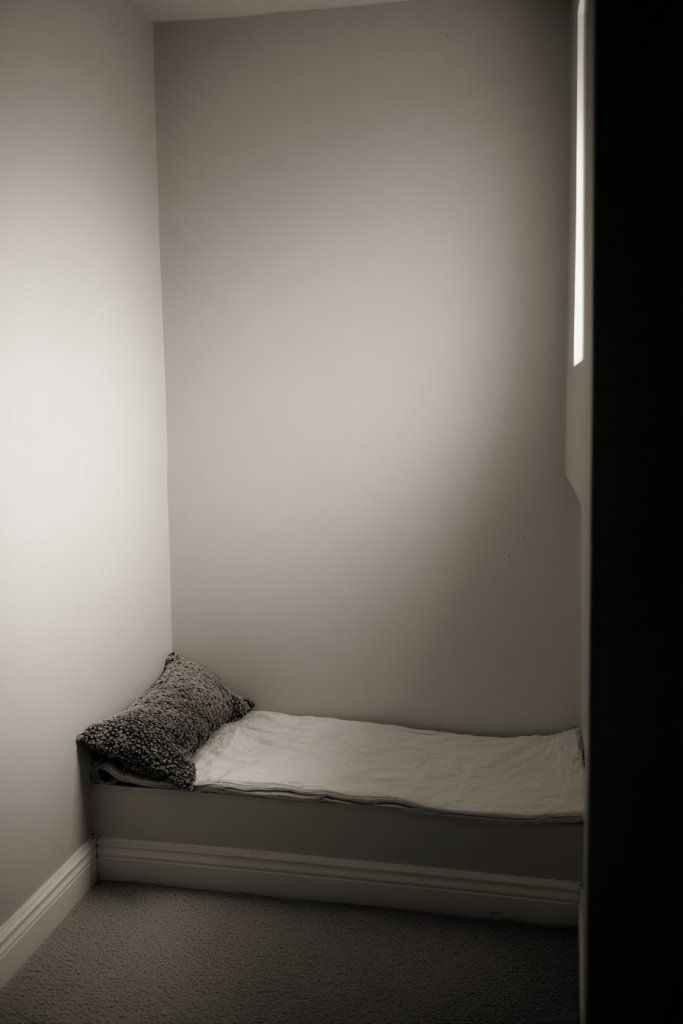
In today’s busy world, finding a moment of peace can feel impossible. Creating a quiet, private nook offers a dedicated space for meditation, reflection, or just peaceful solitude. It’s about carving out a personal retreat within your home—a place to breathe, relax, and reset. Who wouldn’t want a little slice of calm?
Visualize a cozy corner with a comfortable floor cushion or a supportive armchair, surrounded by soft textiles and gentle lighting. A small shelf or basket nearby holds your favorite books or meditation tools. Soft curtains or screens provide privacy from the rest of the house, enhancing the sense of seclusion. The space feels tranquil, inviting you to sit quietly and breathe deeply. It’s a personal sanctuary, simple yet profound.
Personalize your nook with calming colors—pastels, earth tones, or neutral shades—that promote relaxation. Use textures like plush cushions, woven throws, or shaggy rugs to add comfort. Incorporate decorative elements like candles, small sculptures, or a water feature (or a decorative alternative) to enhance serenity. For seasonal changes, add different textiles or lighting options to suit your mood.
Choose a quiet corner in a room with minimal foot traffic. Use a supportive cushion, meditation bench, or comfortable chair to sit peacefully. Install soft lighting—such as a small lamp or fairy lights—that can be dimmed. Add a small side table for essentials like water or a journal. Use soundproofing or soft textiles to dampen noise for a true retreat. Keep the space clutter-free for maximum calm.
Decorate with personal items that evoke tranquility—like photographs, meaningful objects, or textured textiles. Incorporate a small indoor fountain or calming sound machine (if allowed) for ambient noise. Use decorative baskets or storage to keep your space tidy and inviting. Add a few plants or natural elements if permitted, or opt for decorative alternatives that bring a sense of nature.
A dedicated quiet nook encourages mindfulness and self-care, enriching your daily routine. It’s a small investment that pays off in mental clarity and emotional well-being. Creating a space for reflection helps you stay centered and balanced. Embrace this personal sanctuary and enjoy the calm it brings to your life.
17. Smart Home Features for Convenience and Safety

Modern technology offers incredible convenience, especially for those wanting to age comfortably in their homes. Smart home features improve safety, automate routine tasks, and give you peace of mind. It’s like having a personal assistant that’s always on call. Who wouldn’t want a home that works smarter, not harder?
Picture voice-controlled lighting that turns on with a simple command, or remotely adjustable thermostats that keep your home cozy. Smart security systems alert you to any unusual activity, even when you’re away. Automated door locks and video doorbells add layers of safety and convenience. The overall environment feels seamless—tech that blends into your home without fuss.
Choose systems that integrate with your existing devices or opt for comprehensive packages. Use voice assistants like Alexa or Google Home to control lighting, temperature, and even appliances. Install smart sensors on doors, windows, and motion detectors for enhanced security. Customize your setup with user-friendly apps that allow for easy management. Seasonal or lifestyle adjustments can be made effortlessly through these platforms.
Start by assessing your current devices and identify areas where automation could improve safety or comfort. Work with professionals to install compatible systems, ensuring secure Wi-Fi connections. Use voice-controlled hubs for centralized management. Program routines—like turning lights on at sunset or locking doors at night—to streamline daily life. Regular updates and security checks keep everything running smoothly. Keep a backup plan and manual controls in case of tech failure.
Personalize your smart home with custom routines—morning wake-up scenes or bedtime shutdowns. Use decorative covers or enclosures to hide tech components and maintain aesthetic harmony. Integrate voice commands that suit your lifestyle—such as playing your favorite playlist or adjusting lighting for reading. Keep interfaces simple and accessible, especially if you have mobility concerns. The goal is intuitive, effortless control.
Smart home features make daily routines safer and more convenient, freeing your time for what matters most. They empower you to live independently with added reassurance. As technology advances, your home can evolve, staying aligned with your needs. Embrace these innovations and enjoy a safer, more efficient lifestyle.
18. Durable, Easy-Clean Flooring Options
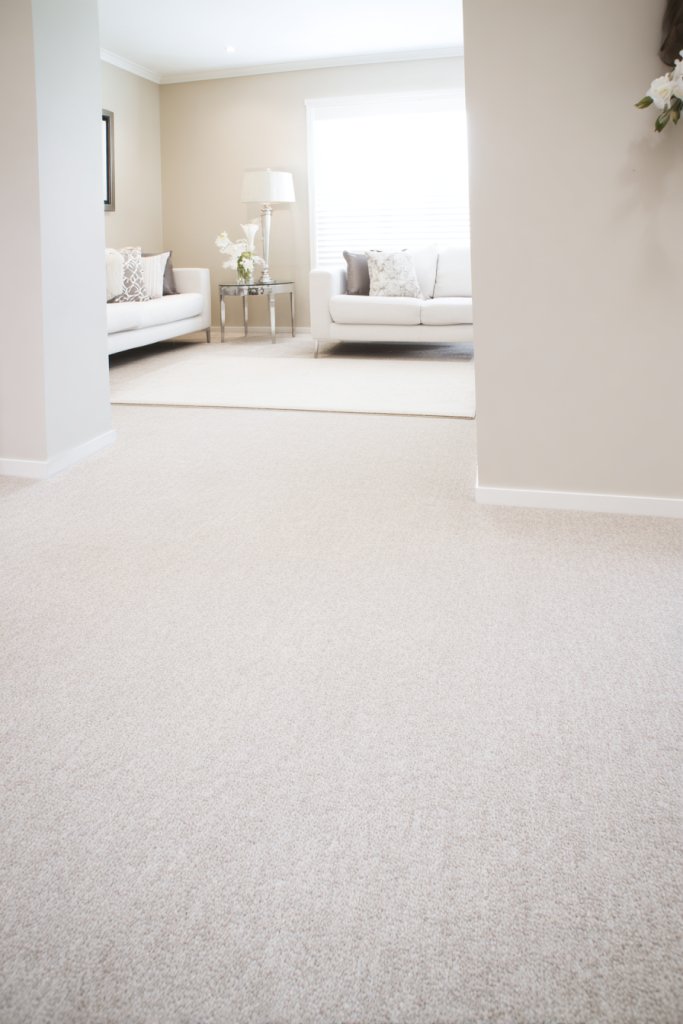
Floors take a beating over the years, especially in busy or multi-purpose spaces. Durable, easy-clean flooring options save you time and effort while maintaining a fresh look. It’s about choosing materials that withstand everyday life without sacrificing style. Who doesn’t want a home that looks great and stays that way?
Imagine a living area with sleek vinyl planks that mimic wood but resist scratches and spills. A kitchen with polished concrete floors that are both stylish and stain-proof. Soft carpets or rugs in bedrooms add comfort but are easy to vacuum and spot-clean. The overall effect is a space that looks polished while handling daily wear and tear effortlessly. It’s a practical choice that keeps your home looking new.
Choose from a variety of materials—laminate, vinyl, cork, or sealed concrete—to match your aesthetic and lifestyle. For high-traffic areas, prioritize scratch and stain resistance. For bedrooms, consider plush carpets or rugs in easy-maintenance fibers. Seasonal updates can include new rugs or coatings to refresh the look. The key is balancing durability with comfort and style.
Start by assessing your space’s needs—consider traffic, spills, and comfort. Work with flooring specialists to select the best material for each room. Install with proper underlayment to prevent damage and improve insulation. Use non-slip finishes in areas prone to moisture, like kitchens and bathrooms. Regular cleaning with suitable products prolongs the lifespan of your floors. Avoid harsh chemicals that can damage surfaces.
Add area rugs or runners in complementary colors and textures to define spaces and add visual interest. Use decorative borders or inlays for a custom look. Incorporate furniture with protective pads to prevent scratches. Keep floors clean and free of debris for safety and longevity. With thoughtful choices, your floors will remain stylish and practical.
Choosing durable, easy-care flooring simplifies home maintenance and keeps your environment safe and attractive. It’s an investment in your home’s longevity and your peace of mind. Every time you walk in, you’ll appreciate the blend of style and practicality. Enjoy a home that stays beautiful with minimal effort.
19. Accessible Laundry Rooms with Adequate Storage
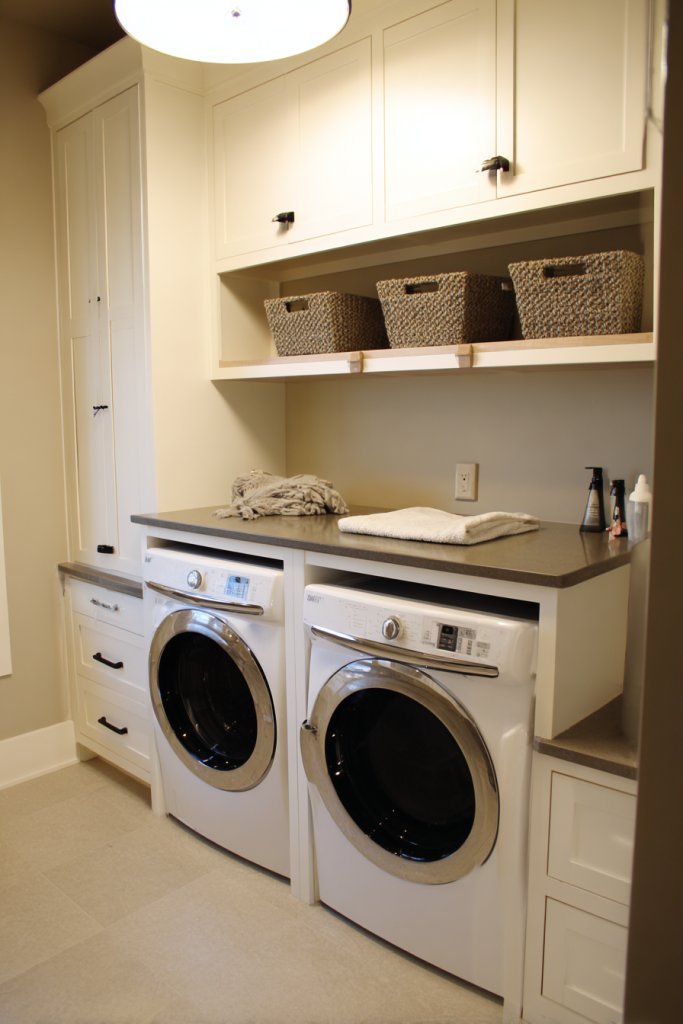
Laundry chores are inevitable, but they shouldn’t be a hassle—especially if mobility or convenience is a concern. An accessible laundry room designed with storage and ease of use in mind makes chores quicker and less stressful. It’s about transforming a mundane task into a smooth, efficient routine. Who wouldn’t want a laundry space that works for you?
Visualize a main-floor laundry area with front-loading appliances at waist level, making loading and unloading effortless. Bright, adjustable lighting illuminates organized shelves and cabinets holding detergents, fabric softeners, and cleaning tools. Built-in hampers and pull-out baskets keep laundry sorted, while a folding station provides a dedicated workspace. The space feels open, organized, and designed for everyday convenience. It’s a practical yet tidy hub for laundry day.
Select appliances with ergonomic access and controls, including touchscreens or voice commands if possible. Use adjustable shelving and storage bins for flexibility. Incorporate fold-out ironing boards or compact drying racks to save space. For seasonal needs, add hooks or retractable drying lines. Keep surfaces smooth and easy to wipe clean, and ensure pathways are wide enough for mobility aids.
Begin by choosing a location that’s easily accessible—preferably on the main floor. Install front-loading appliances at adjustable heights to minimize bending. Use durable, waterproof flooring—like vinyl or sealed concrete—for easy cleaning. Organize supplies in labeled bins or pull-out drawers for quick access. Include ample counter space for folding and sorting. Regularly check for leaks or damage to maintain safety and efficiency.
Add decorative touches like painted or patterned backsplashes to brighten the space. Incorporate a small plant or decorative container (avoiding restricted decor) for a personal touch. Use stylish, functional storage containers for detergents. Keep cleaning tools within easy reach using wall-mounted holders. Make the space inviting and efficient—your laundry routine will thank you.
An accessible laundry room simplifies chores and promotes independence, making home life easier. It’s a practical upgrade that saves time and effort while keeping everything organized. With a well-designed space, laundry day becomes a less daunting task. Enjoy the convenience and peace of mind that comes with a perfect setup.
20. Inviting Entryways with Practical Storage Solutions
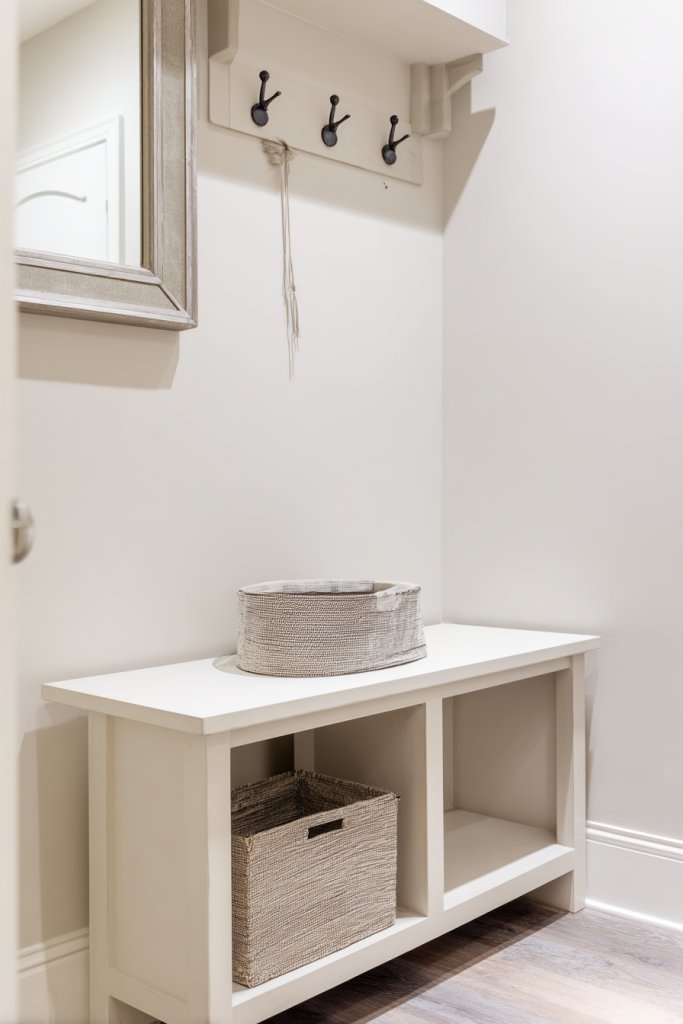
Your entryway sets the tone for your home, yet it often becomes a cluttered catch-all. An inviting, organized entryway welcomes you and guests with style and functionality. It’s about making the first impression count while providing practical storage for everyday essentials. Who wouldn’t want an entry that’s both beautiful and efficient?
Imagine a welcoming space with a sturdy bench topped with a textured cushion, next to a row of hooks for coats and a sleek shoe rack below. Decorative baskets or bins hold umbrellas, hats, or scarves, keeping everything tidy. A mirror with a simple frame expands the space visually, while a small console table offers a spot for keys or mail. The overall look is warm, organized, and inviting—a true homecoming.
Choose furniture and storage that match your decor style—rustic wood with metal accents for farmhouse charm or sleek, minimalist designs for modern homes. Use baskets or bins made from natural fibers for a cozy touch. Seasonal updates can include decorative pillows or throws on the bench. Incorporate hooks or racks that accommodate all your family’s needs, adding flexibility and charm. Keep the space clutter-free for maximum impact.
Start by clearing the space and measuring available wall and floor area. Install durable hooks, pegs, or wall-mounted racks at accessible heights. Use a bench with built-in storage or a small table with drawers for additional organization. Choose weatherproof and easy-to-clean materials for durability. Add a mirror and decorative accents to enhance the aesthetic. Regularly tidy and update for seasonal needs or new family members.
Personalize with decorative cushions, small art pieces, or seasonal accents. Use labeled baskets or bins for specific items—like shoes, umbrellas, or keys—to keep everything in place. Incorporate a small plant or decorative item that adds personality without clutter. Keep the decor simple yet functional, making coming and going a pleasant experience. Every detail should serve both form and function.
A thoughtfully designed entryway enhances your home’s first impression and daily routine. It reduces clutter, saves time, and creates a welcoming atmosphere. With a little planning, your entry becomes a charming, organized space that makes every return enjoyable. Embrace a stylish, functional entrance that sets the tone for your entire home.
21. Compact Home Offices with Ergonomic Setup
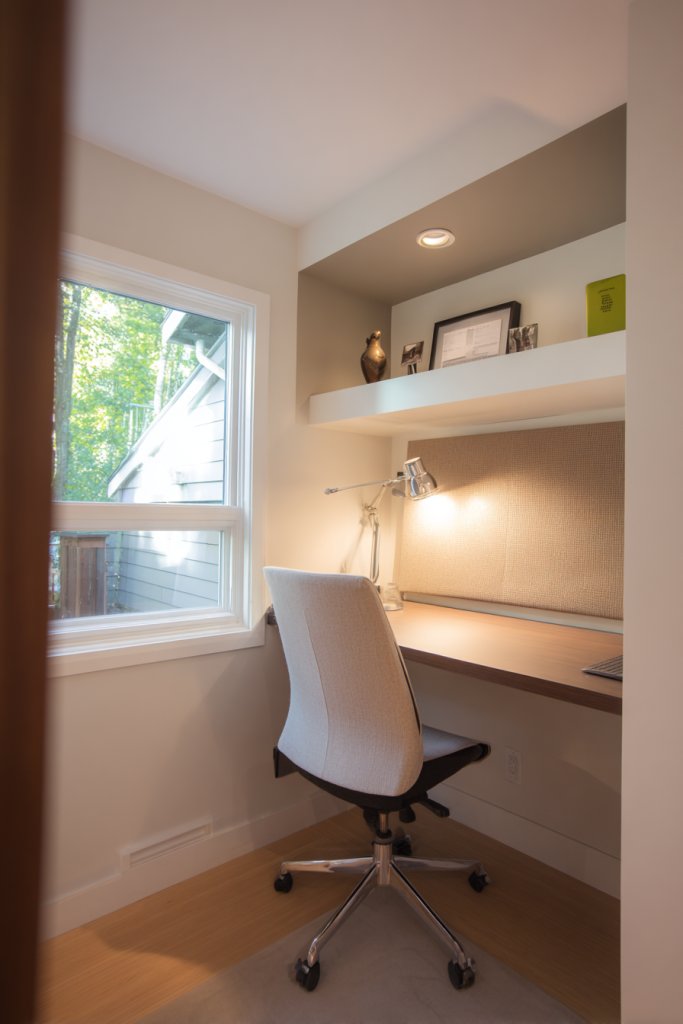
Working from home can blur the lines between relaxation and productivity, especially in cramped spaces. A compact, ergonomic home office promotes focus and comfort, making work less stressful and more efficient. It’s about creating a dedicated space that encourages creativity and minimizes fatigue. Who wouldn’t want a workspace that feels good and works well?
Imagine a small corner with a sleek desk that has adjustable height settings, paired with an ergonomic supportive chair. Shelves above hold essential supplies in accessible containers, while a small task lamp provides focused lighting. The space is uncluttered, with a neutral color palette that promotes calm. A corkboard or whiteboard keeps reminders within reach. It’s a functional, stylish workspace designed for productivity.
Choose furniture with clean lines and adjustable features—such as a sit-stand desk or supportive chair—to suit your needs. Use smart storage solutions like wall-mounted organizers or labeled drawers to keep essentials tidy. Decorate with inspiring artwork or motivational quotes (if allowed) to personalize the space. Seasonal updates might include a new cushion or a fresh coat of paint to keep the environment stimulating. The key is adaptability.
Start by selecting a quiet, well-lit corner with sufficient space for furniture and movement. Invest in ergonomic furniture that supports proper posture. Use cable management systems to keep cords organized and out of sight. Install shelves or wall-mounted storage to maximize space. Use lighting that reduces eye strain—LED or natural light when possible. Keep the area tidy with dedicated storage for supplies and documents.
Add personal touches like inspiring posters, textured desk mats, or decorative storage containers. Incorporate a small plant or natural element if permitted, or decorative textured accents. Use a supportive cushion or lumbar pillow on your chair for extra comfort. Keep the decor minimal but meaningful—perhaps a favorite book or decorative object. Make it a space that motivates and relaxes.
A well-designed home office boosts productivity and creates a dedicated mental space for work. It helps separate professional tasks from leisure, supporting mental clarity. With a little effort, your workspace can inspire focus and reduce fatigue. Embrace this functional, personalized environment and enjoy working comfortably at home.
22. Personal Wellness Spaces for Yoga or Meditation
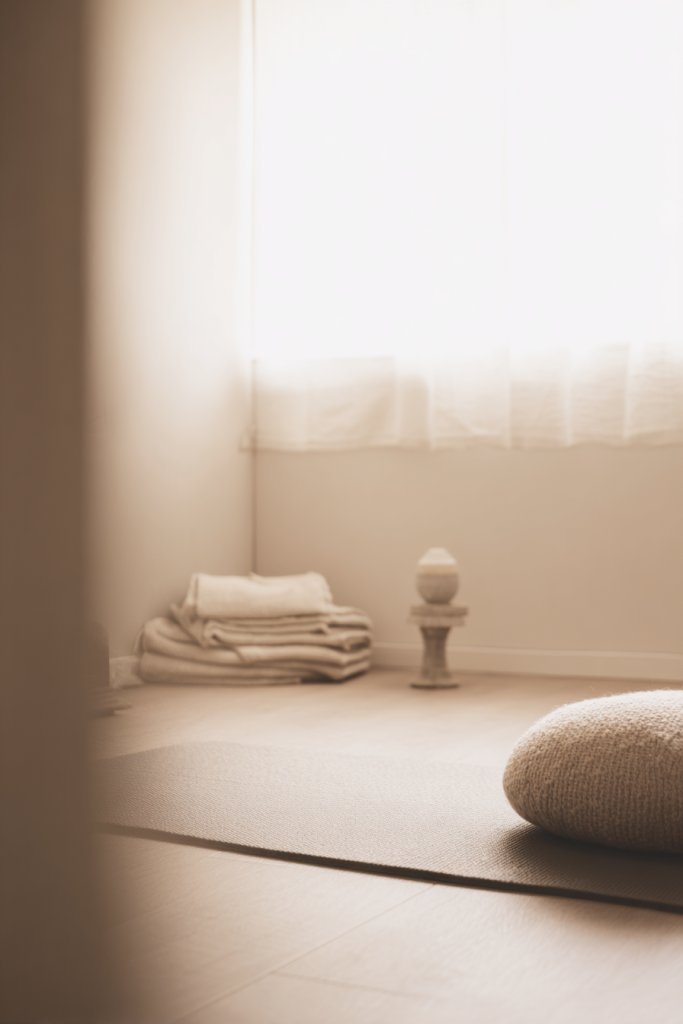
In our busy lives, finding a moment of calm can feel impossible. A dedicated wellness space for yoga or meditation offers a retreat where you can reconnect and recharge. It’s about creating a peaceful environment that nurtures your mental and physical health. Who wouldn’t want a personal sanctuary for self-care?
Picture a small, uncluttered corner with a soft, textured mat, a supportive cushion, and gentle lighting. The space features calming colors—soft blues, earthy greens, or neutrals—that promote tranquility. Minimal decor like a small sculpture or decorative stones (avoiding restricted items) adds a natural touch. A window with sheer curtains lets in natural light, creating a soothing atmosphere. It’s a dedicated zone for peace and mindfulness.
Style the space with calming textures—like woven mats, soft blankets, or textured cushions. Use natural materials like wood or stone accents for a grounding effect. Seasonal updates might include new textiles or decorative elements that evoke different moods—warm in winter, airy in summer. Keep the area simple, focusing on comfort and serenity. Personalize with meaningful objects or symbols that inspire calm.
Choose a quiet, accessible corner with enough space for movement and comfort. Use a high-quality, non-slip yoga mat or cushion, and add supportive props like blocks or straps if needed. Ensure good ventilation and soft lighting—preferably natural or warm artificial light. Keep the space free of clutter and distractions. Regularly refresh textiles and cleaning supplies to maintain a clean, inviting environment. Incorporate a small shelf or storage for essentials.
Make it truly yours with textured textiles, calming scents (like lavender in diffusers), or decorative objects that evoke serenity. Use decorative baskets or organizers to keep supplies tidy. Incorporate a small speaker for guided meditations or calming music. Keep the decor minimal but meaningful—perhaps a framed quote or a natural sculpture. Focus on creating a space that feels safe and restorative.
A personal wellness space encourages daily self-care and mindfulness, boosting overall well-being. It’s a small investment in your health that pays dividends in mental clarity and happiness. Embrace this dedicated area to cultivate calm and resilience. Every time you enter, you reinforce a habit of peace and self-love.
23. Eco-Friendly Design Elements for Sustainable Living
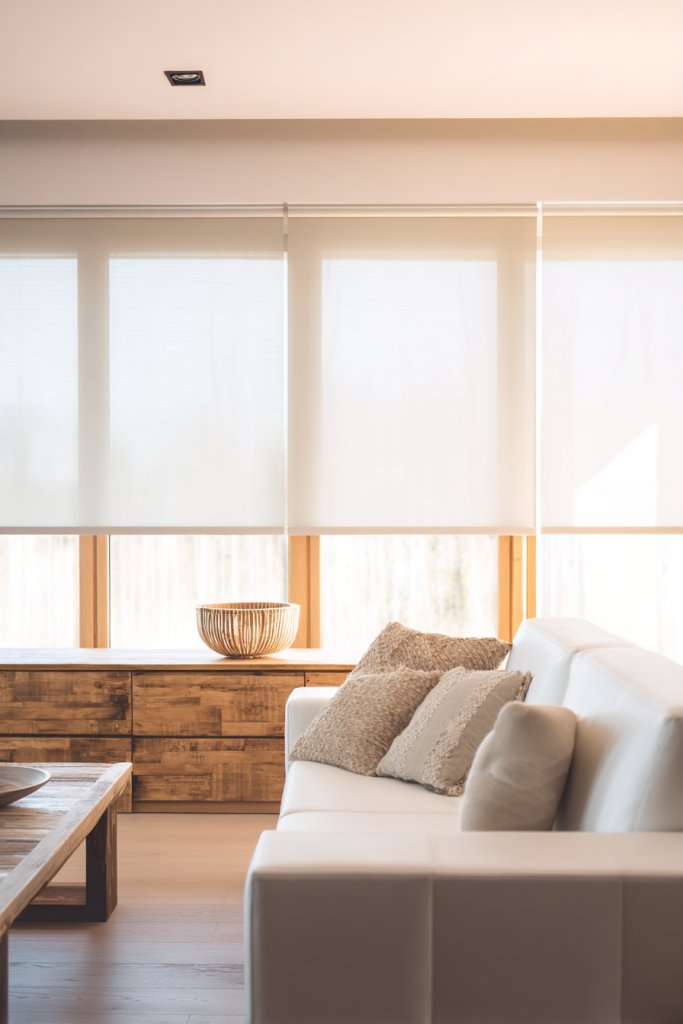
Sustainable living isn’t just trendy—it’s a responsible choice for the planet and your wallet. Incorporating eco-friendly design elements into your home reduces waste, conserves energy, and creates a healthier environment. It’s about making mindful choices that benefit both you and future generations. Who wouldn’t want a home that’s good for the Earth?
Imagine solar panels on the roof, seamlessly integrated into the design. The home features reclaimed wood accents, low-VOC paints, and energy-efficient windows that let in natural light while reducing heat loss. Inside, water-saving fixtures and eco-friendly materials like cork or bamboo flooring add warmth and sustainability. The overall aesthetic is modern, clean, and aligned with green principles. It’s a home that looks good and feels right.
Choose materials that are renewable, recycled, or locally sourced—think bamboo cabinetry or recycled metal fixtures. Incorporate energy-saving appliances and smart technology to optimize usage. Use natural insulation materials and passive solar design strategies for climate control. Seasonal updates might include planting native, drought-resistant plants or adding solar-powered garden lights. The goal is to blend style with sustainability.
Start by auditing your current home’s energy and water use. Work with professionals to install solar panels, upgrade insulation, and replace old fixtures with water-efficient models. Choose finishes with low or zero VOC emissions to improve indoor air quality. Incorporate rainwater harvesting or greywater systems if possible. Select durable, eco-friendly materials for renovations or upgrades to ensure longevity and minimal environmental impact. Regular maintenance keeps systems efficient.
Personalize your eco-conscious home with decorative elements made from recycled or natural materials—like textured rugs, woven baskets, or handcrafted accessories. Use energy-efficient lighting options, like LED bulbs or solar-powered fixtures. Incorporate a vegetable garden or compost area to reduce waste and produce your own food. Keep sustainable choices consistent throughout your decor for a cohesive look. Celebrate your eco-friendly lifestyle.
Eco-friendly design isn’t just good for the planet—it elevates your quality of life and sets a positive example. It’s a meaningful way to live consciously and stylishly. Your home becomes a reflection of your values—beautiful, responsible, and inspiring. Embrace sustainability and enjoy the peace of mind that comes with making a difference.
Conclusion
Exploring these diverse retirement house plans opens up a world of possibilities for your ideal living space. Whether you prefer a cozy cottage, a modern retreat, or a spacious bungalow, there’s an idea here to suit your style. Embrace these concepts and start transforming your home into a relaxing oasis—your perfect retirement retreat awaits!